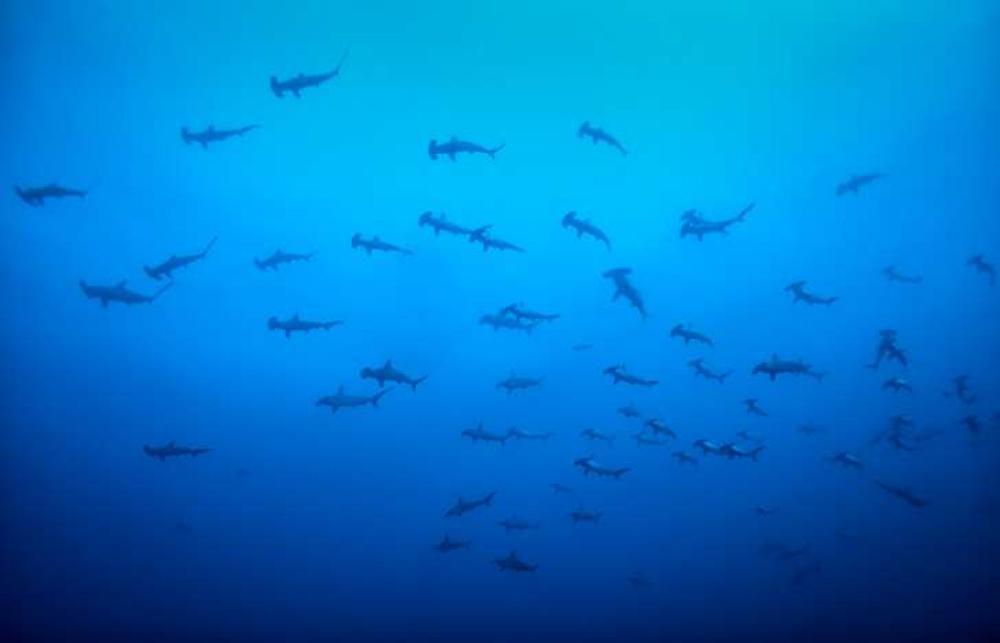Hammerhead Shark Facts in a nutshell
Their oddly-shaped heads could help them swim, or improve their vision, or any of a host of other things
The unusual structure of the head makes the head look like a hammer, this is why they are known as "Hammerhead sharks". This "hammer" on its head is also known as the "cephalofoil" Since the eyes are positioned on the ends of the cephalofoil, hammerheads are able to see everything around them, including what is under them, and what is above them. This head helps hammerhead sharks make very tight turns in the water, and it also helps them sense prey.
Did you know:
Hammerheads have special sensors on their heads that detect the electrical signals of other animals
Feeding
Hammerhead sharks are aggressive hunters and feed on crustaceans, molluscs like octopuses and squids, and many types of fish.
• Their favourite type of food is stingrays.
Hammerhead sharks use their cephalofoil (hammer) as a weapon to hunt for stingrays If a stingray is found just above the ocean floor, a hungry great hammerhead will use its cephalofoil weaken the prey by pinning the creature against the sand. Then, with a bite to the pectoral fin (or “wing”), the stingray is immobilized. However, they doesn't always escape unscathed: Great hammerheads are often found with stingray barbs on their faces.
• When Hammerhead Sharks cannot find food, they have been known to eat each other, other types of sharks and even their own young.
One possibility is that the flattened head enhances the shark's swimming performance
Reproduction
Hammerhead Sharks are viviparous, meaning they give live birth. Once they are born, baby Hammerhead sharks come together in groups and swim towards warmer waters.
• They stay together in groups until they are older and big enough to live on their own.
• Hammerhead sharks live for around 20 to 30 years.
• Out of the nine species of Hammerhead sharks three are dangerous to humans: the Scalloped Hammerhead shark, the Great hammerhead shark, and the Smooth Hammerhead shark.
• The Smalleye Hammerhead shark is listed as vulnerable. This is because of over-fishing for the fins of Hammerhead sharks, which are used in sharkfin soup

Great hammerheads like to swim sideways
A typical shark has eight fins on its body, the most recognizable is the dorsal fin; it typically acts like a sailboat keel, helping the shark stay balanced while it swims.
- For hammerheads, the opposite is true. And that has a big effect on how these animals move. When swimming they tilt to one side Why’d they do this? It’s thought that after a hammerhead rolls sideways, the creature’s first dorsal fin acts like one of the pectoral fins. This reduces drag while also increasing the animal’s “wingspan.” Both factors enable the shark to swim more efficiently.
Some hammerheads are endangered
- There are nine known species of Hammerhead sharks.
- Three hammerhead species have a high risk of extinction: the great hammerhead, which is threatened by the shark fin trade and fishing bycatch

Where do hammerhead sharks roam in the ocean?
Found in all temperate and tropical waters worldwide, all species are assumed to be highly migratory. In South Africa, adults are found offshore in deeper waters, while juveniles are very common inshore often swimming just under the surface.
Some hammerheads travel in schools
Though many sharks are solitary creatures, scalloped hammerheads—which can reach lengths of 10 to 12 feet and can weigh in at 300 pounds or more—form schools.
- The young sharks probably travel in schools for mutual protection, but nobody knows why full-grown scalloped hammerheads, which have few natural predators, congregate like this.
- The behaviour may have something to do with their migration patterns or mating habits.
- Some schools are exclusively made up of females while others contain sharks of both sexes and different ages.
- In adults-only groups, the fish tend to disperse at night before meeting back up during the day.

Interesting FOLKLORE
In Hawaiian culture, sharks are considered to be gods of the seas, they are also known as aumakua, protectors of humans, and cleaners of ocean life. The Hammerhead sharks are known as mano kihikihi and are not considered as man-eaters or niuhi, but are considered one of the most respected sharks in the oceans, an aumakua.
Many Hawaiians believe that they have an aumakua which watches over them and protects them from the niuhi.
Source
Various: Web
Call us and schedule your listing today! Contact Us
Copyright © 2025 Hermanus Online Magazine. Web Development by Jaydee media.


